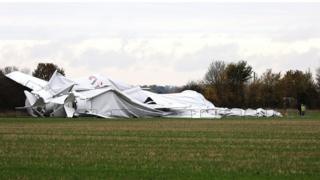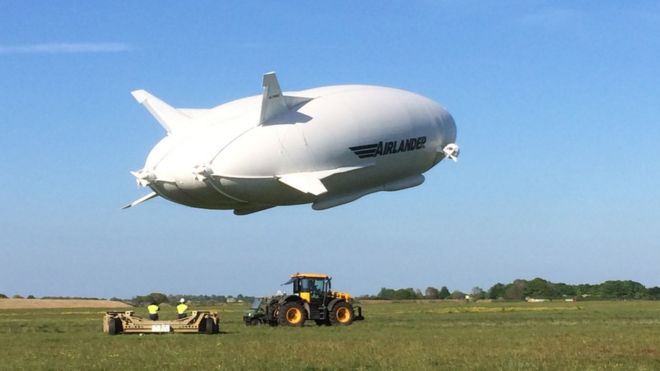blessmycottonsocks
Antediluvian
- Joined
- Dec 22, 2014
- Messages
- 9,399
- Location
- Wessex and Mercia
I initially misread that as "a flying whorehouse".
Hmmm.....
Hmmm.....
I initially misread that as "a flying whorehouse".
Hmmm.....

Likely the only use they will find for it, and then only on very still windless days.I initially misread that as "a flying whorehouse".
Hmmm.....
Airlander 10 'breaks in two' and collapses at Cardington
- 18 November 2017
- From the sectionBeds, Herts & Bucks
Image copyrightSBNA
Image captionThe airlander collapsed at Cardington Airfield, where it is based
The world's longest aircraft has collapsed to the ground less than 24 hours after a successful test flight.
The Airlander 10 - a combination of a plane and an airship - was seen to "break in two" at an airfield in Bedfordshire, an eyewitness said.
Owner Hybrid Air Vehicles Ltd said it appeared the Airlander broke free from its mooring mast, triggering a safety system which deflates the aircraft.
Two people on the ground suffered minor injuries.
etc
Blimp tows water skier across Southern California lake
... The Press-Enterprise reports the blimp towed skier Kari McCollum for 6.9 miles (11.1 kilometers) at Lake Elsinore on Tuesday.
The newspaper says that’s a new record, according to Philip Robertson, an adjudicator with Guinness World Records.
The old mark for a water skier being towed by a blimp or airship was nearly 5 miles (8 kilometers). ...
One of the Goodyear blimps that were used for advertising had a interesting passed.
https://www.popularmechanics.com/military/aviation/a27808/the-goodyear-blimps-ghostly-past/
http://earth-chronicles.com/anomali...-disappeared-crew-of-the-us-navy-airship.html
Airlander 10: World's longest aircraft grounded
- 5 hours ago
- Share this with Facebook
- Share this with Messenger
- Share this with Twitter
- Share this with Email
- Share
Image copyrightHYBRID AIR VEHICLESImage captionAirlander took its first flight in 2017 from Cardington Airfield
The world's longest aircraft has been permanently grounded as developers prepare to start work on a new model.
The £32m Airlander 10 - a combination of plane and airship - had completed six test flights before it collapsed to the ground in November 2017.
Hybrid Air Vehicles (HAV), based in Bedford, said it had received Civil Aviation Authority backing to start work on a new craft.
It is hoped the new model will take to the skies in the early 2020s.
etc
In November 2017, the airship broke free from its moorings. This triggered an automatic safety feature which deflated the airship so that it would not drift and cause damage to property or a hazard to air traffic. This caused it to crash to the ground and break up.I was just thinking the other day that things had gone quiet about this.
https://www.bbc.co.uk/news/uk-england-beds-bucks-herts-46810151
As a dinghy sailor and general boating enthusiast, I'd say the wind can be a friend as well as an enemy. It's like the tide: you can work with it or you can fight against it.They are not really practical due to the problem of wind.
As an observation platform, just keeping them on station is problematic.
But for occasional use in the right conditions they are very useful.
INT21.
From the History Restored YouTube Channel. The clearest footage I've seen of the disaster.
There was some talk a few years ago of developing new passenger airships, helium filled, rather than hydrogen.I would personally love to travel by Airship.
A proper big one, with all the facilities and amenities on board, y'know, a bar, restaurant, observation lounge etc etc.
They did it with the R101 and Hindenburg (okay so there were disasters) which shows it is possible.
There was some talk a few years ago of developing new passenger airships, helium filled, rather than hydrogen.
I would personally love to travel by Airship.
A proper big one, with all the facilities and amenities on board, y'know, a bar, restaurant, observation lounge etc etc.
They did it with the R101 and Hindenburg (okay so there were disasters) which shows it is possible.
The problem with hot air is it doesnt stay hot very long hence the need for bloody great burners in hotair ballons, which are great btw, if you have never been up in one i highly recommend it.I'm not worried about newts but the world is running out of helium. Hot air might be a better option.
There was some talk a few years ago of developing new passenger airships, helium filled, rather than hydrogen.
FULL STORY (With Photos): https://www.livescience.com/hindenburg-disaster-newfound-footage.htmHindenburg disaster's earliest moments captured in newly released footage
A bystander captured the film in a location apart from the newsreel cameras.
When the enormous German airship Hindenburg burst into flames on May 6, 1937, during a flight over New Jersey, it ignited in seconds before crashing to the ground in front of horrified onlookers. Now, footage that captured the early moments of the disaster ... could offer new clues as to what sparked the blaze.
On the day of the accident, news photographers were already filming the Hindenburg at the Naval Air Station in Lakehurst, New Jersey. When they realized the airship was burning, they rushed to record images of the rapidly spreading blaze, and the best-known footage and photos of the disaster all show it from a similar angle.
However, an amateur photographer named Howard Schenck was also at the scene with a Kodak 8-millimeter consumer film camera — but he was at a different spot on the field. Schenck realized that the Hindenburg was on fire and began filming earlier than the newsreel photographers, and his wide-angle lens and side view of the airship captured the Hindenburg's entire length as it burned, offering a perspective that was missing in the news cameras' coverage. ...
called the "Titanic of the skies"
